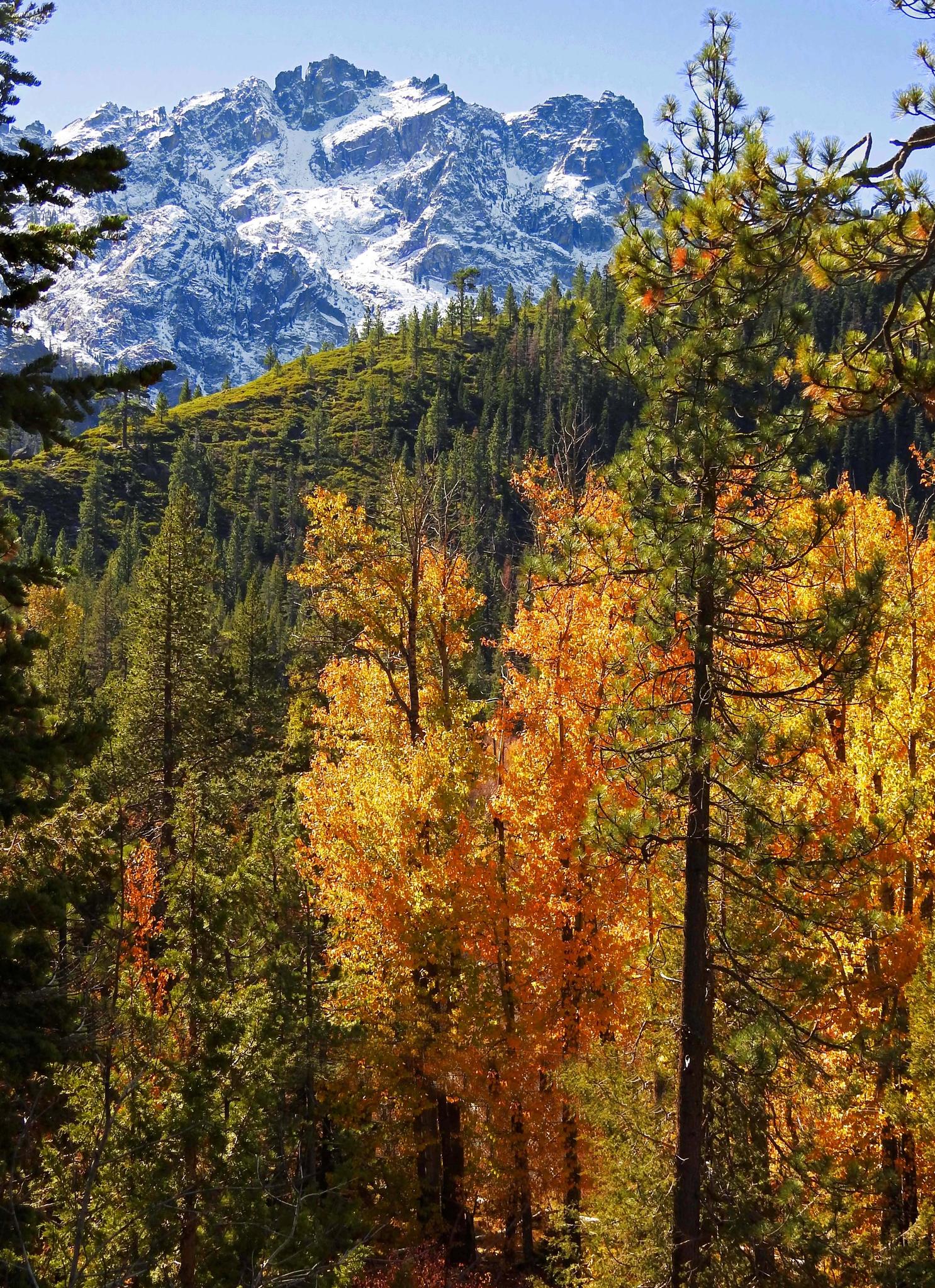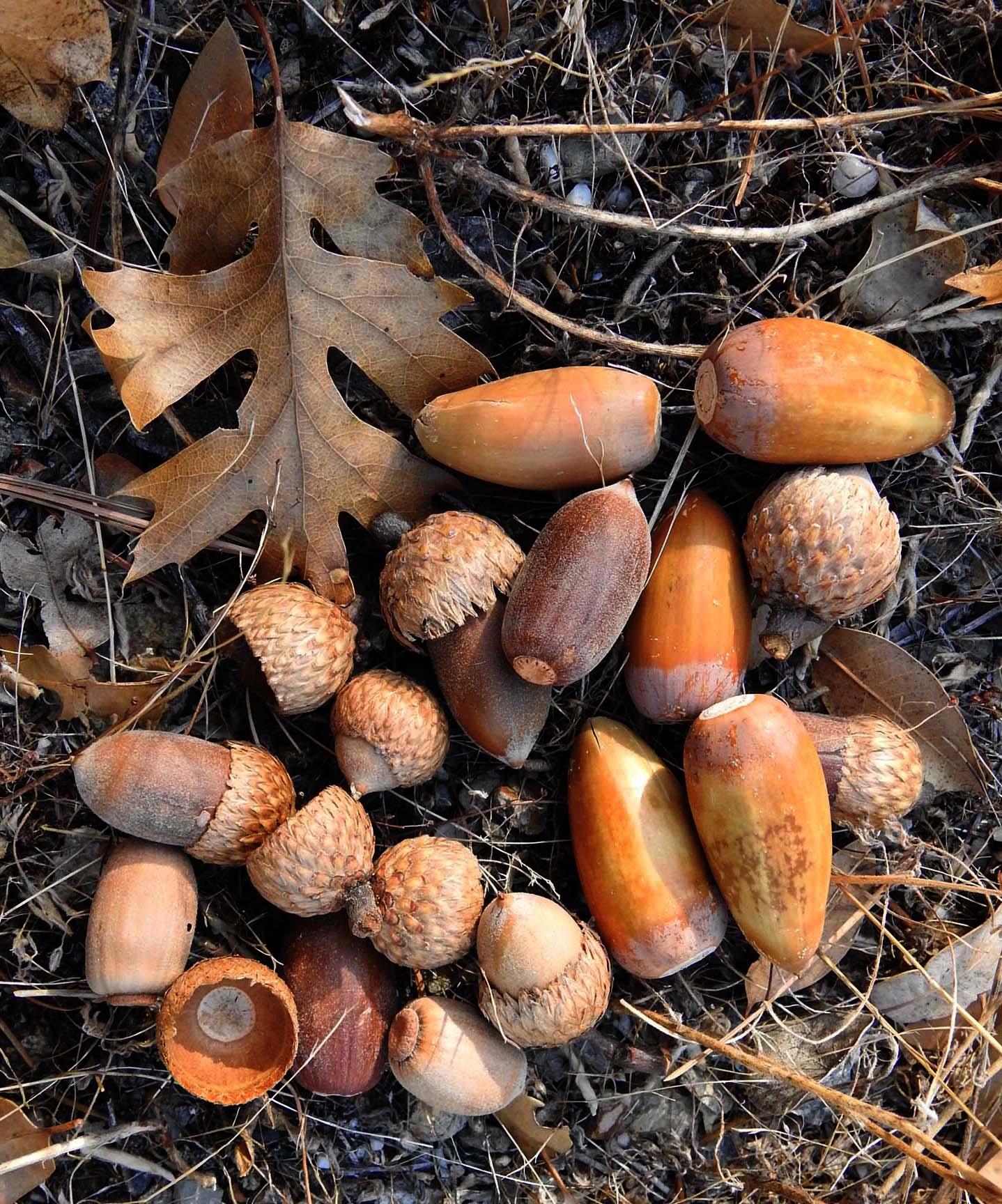The Last Beautiful Days of Autumn!
November 26, 2024

First snow on the Sierra Buttes — 11/4/24
The first snows in the Lakes Basin happened about two weeks ago! My husband and I drove up to go for a hike, only to find that the trails around 6,000’ had 2”-4” of snow! It was lovely to see, but a bit too slippery to go hiking! Since then we’ve had several rainy, cold days with a total of 1.07” of precipitation locally, which probably brought additional snow to the Lakes Basin. Luckily the Fall color is persisting and orange, maroon, pinkish-red, golden-yellow, amber, ochre, and burnt sienna leaves are still painting the landscape!

Sierra Buttes from the Deer Lake Trail — 11/6/24
This week, my friend Nancy and I decided to go for one last hike in the Lakes Basin before winter sets in. We hiked up the Deer Lake Trail to an off-trail pond where we often see salamander larvae. There was a good 3”-4” inches of snow on the ground in the shady forest, but the sunny areas were snow free. However, it was quite blustery and COLD! The pond was dry, and covered in an inch of snow. There wasn’t a salamander in sight, as it was way too dry and cold. They are probably in brumation-mode under some fallen log or forest duff. The view of the Buttes on the way back to our car was stunning! It was a wonderful end-of-the-season hike in our home away from home!
The Halls Ranch to Fiddle Creek Trail
Every Fall, for the past four years, my friend Diane and I hike the Halls Ranch to Fiddle Creek Trail. The trail initially climbs to a ridgetop, with a 2,105’ gain in elevation in the first two miles. Once you reach the top of the ridge, there is a glorious view of the distant Sierra Buttes! This year we saw the Buttes with its first dusting of snow! Well worth the steep hike! The trail then passes through a gorgeous mixed deciduous/conifer forest, containing Black Oaks, Tan Oaks, Canyon Live Oaks, Big Leaf Maples, Dogwoods, Douglas Firs, Sugar Pines, Ponderosa Pines, Incense Cedars, and White Firs, for the next seven miles.

Merlin — Falco columbarius
To my surprise and delight, I spotted a Merlin perched on a pine tree on the ridgetop! Wow!!! It posed for us for a short time and then flew off! These tiny falcons are uncommon in our area! What a thrill it was to see one!!!
These falcons are only 10” long including the tail, with a wingspan of 6.5”, and a weight of 6.7 ounces! They’re tiny! Their main diet is small to medium size birds. They usually hunt from a perch. Prey is pursued with lightning speed (30 mph or more), and caught mid-air. In the fall they eat a lot of dragonflies! Sometimes they even hunt cooperatively with another Merlin!
It turns out that these little falcons don’t breed here, they breed farther north across Alaska and Canada, as well as Russia! They are not numerous in population, but they are widespread. They are uncommon visitors to our area in the fall and early winter, during their migration to their winter residence in Mexico/So. America.

Morning Mists above the North Yuba River Canyon
We were up on the ridgetop early enough to watch the mists rise from the forest as the sun rose! Such graceful beauty!!!

Townsend’s Solitaire (adult) — Myadestes townsendi
In the winter, Townsend’s Solitaires are uncommonly seen on the western side of the Sierra where we live! They mainly live and breed on the eastern side, and feed on juniper berries in the winter. However, I usually see one or two of these birds on our annual hike. Apparently some drop down to the western foothills to spend the winter! So this one was probably just passing through on its way to lower elevations for the winter. They mainly eat insects and spiders in the summer, berries and fruit in the winter.

California Black Oaks — Quercus kelloggii
California Black Oaks are one of the many native, deciduous trees in our forests. Even though it has been an extremely dry year, the local oaks still have incredible fall color. I just love how the navy-blue background of the shadowed river canyon showcases the golden-yellow and orange oak leaves! Just stunning!

California Black Oaks — Quercus kelloggii
There were tons of acorns on the trail this year, literally 1,000’s of them on the ground! Last year there were hardly any! They made hiking a bit of a challenge, and more than one of us slipped on them!
Acorn crops vary greatly from year to year. Some scientists have actually estimated that in a high yield year, there can be as many as 250,000 acorns per acre!!!! Bumper crops apparently occur, on average, 2 out of every 10 years. Since so many critters eat acorns, scientist think that oaks may vary their acorn production levels to control critter populations. If they had bumper crops of acorns every year the critters that eat them would also increase in population. This population increase could potentially decrease the amount of new trees sprouting from uneaten acorns.
Your questions and comments are appreciated. Please feel free to email me at northyubanaturalist@gmail.com. Thanks!
Featured Articles

Downieville Gains New Paramedic, Welcome Party Saturday →
April 16, 2025
Downieville welcomes new paramedic Cory Schiemann and bids farewell to Tegan Harrington.
Sierra County Approves Local Roadway Safety Plan →
April 15, 2025
CDFW Releases Updated Black Bear Conservation and Management Plan →
April 14, 2025
Plumas Supervisors Declare Gray Wolf Emergency, Send Letter to CDFW →
April 16, 2025
FCMAT Slams Past PUSD Leadership as Deficit Soars to $8.7 Million →
April 11, 2025